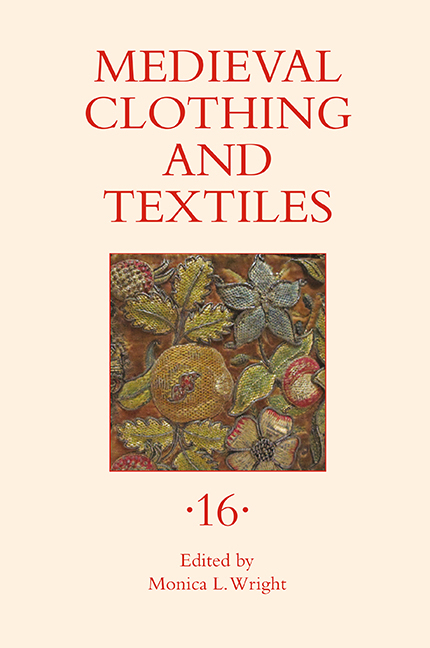Book contents
- Frontmatter
- Contents
- Illustrations
- Tables
- Contributors
- Preface
- 1 Anglo-Saxon Banners and Beowulf
- 2 The Use of Curved Templates in the Drawing of the Bayeux Tapestry
- 3 Construction and Reconstruction of the Past: The Medieval Nordic Textile Heritage of Hemp
- 4 Historicizing the Allegorical Eye: Reading Lady Mede
- 5 Sex, Lies, and Verdugados: Juana of Portugal and the Invention of Hoopskirts
- 6 Fashion and Material Culture in the Tabletop of the Seven Deadly Sins Attributed to Hieronymus Bosch
- 7 The Broderers’ Crown: The Examination and Reconstruction of a Sixteenth-Century City of London Livery Company Election Garland
- Appendix 7.1 Surviving Sixteenth-and Seventeenth-Century Embroidered Crowns of the City of London Livery Companies
- Recent Books of Interest
- Author Index, Volumes 1–15
3 - Construction and Reconstruction of the Past: The Medieval Nordic Textile Heritage of Hemp
Published online by Cambridge University Press: 27 March 2021
- Frontmatter
- Contents
- Illustrations
- Tables
- Contributors
- Preface
- 1 Anglo-Saxon Banners and Beowulf
- 2 The Use of Curved Templates in the Drawing of the Bayeux Tapestry
- 3 Construction and Reconstruction of the Past: The Medieval Nordic Textile Heritage of Hemp
- 4 Historicizing the Allegorical Eye: Reading Lady Mede
- 5 Sex, Lies, and Verdugados: Juana of Portugal and the Invention of Hoopskirts
- 6 Fashion and Material Culture in the Tabletop of the Seven Deadly Sins Attributed to Hieronymus Bosch
- 7 The Broderers’ Crown: The Examination and Reconstruction of a Sixteenth-Century City of London Livery Company Election Garland
- Appendix 7.1 Surviving Sixteenth-and Seventeenth-Century Embroidered Crowns of the City of London Livery Companies
- Recent Books of Interest
- Author Index, Volumes 1–15
Summary
Ever since cultural researchers in Scandinavia began collecting textile artifacts in the late nineteenth century, both the study of locally sourced raw materials and the study of textile production from peripheral regions have been marginalized, whereas the techniques used to make textile arts have enjoyed much greater scholarly attention. Museums have collected and stored textiles for their ability to reveal cultural practices of the past, but they have not documented the growth and production of textile fibers from plants that were grown locally by households in geographically isolated peripheral regions. This is especially true for textiles made of hemp (Cannabis sativa L.), although hemp was a common material in preindustrial home production throughout the world, and the result is that hemp textiles have often been invisible in historical contexts. One reason for this neglect is that the examination of hemp textiles falls between two disciplines: cultural studies on the one hand, and natural science on the other. A number of researchers have studied the cultural aspects of Scandinavian plant-based textile artifacts, while natural scientists have taken less interest in studying the physical properties of the extant textiles. Another reason is that hemp textiles are commonly recorded as “linen” or “flax” in most museum records without analysis of the plant fiber content. The problem in visually distinguishing between different plant fibers has not been sufficiently addressed, and there are few reports clearly demonstrating how these textile analyses have been conducted, which creates a gap in cultural and historical knowledge about medieval Scandinavians’ use of natural resources. It is notable that in recent decades, archaeology has shed new light on textiles made of plant fibers due to an increased number of finds in Europe which have also been well analyzed. What this article seeks to highlight is the importance of common terminology and interdisciplinary research that bridges the divide between botany and other disciplines dealing with historical textiles and plant materials.
The exclusion of plants, nature, people, and/or the environment in historical textile research has resulted in our overlooking key aspects: for example, textile production that has long been going on in geographically peripheral areas, such as mountainous areas, and women's knowledge of plant cultivation.
- Type
- Chapter
- Information
- Medieval Clothing and Textiles 16 , pp. 67 - 84Publisher: Boydell & BrewerPrint publication year: 2020



